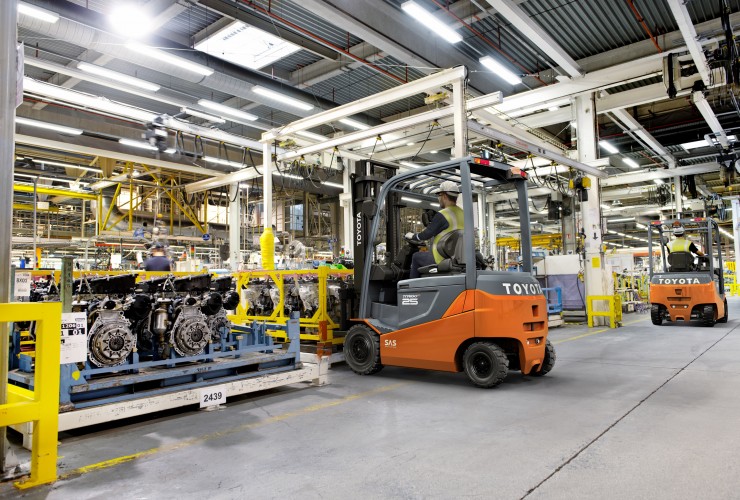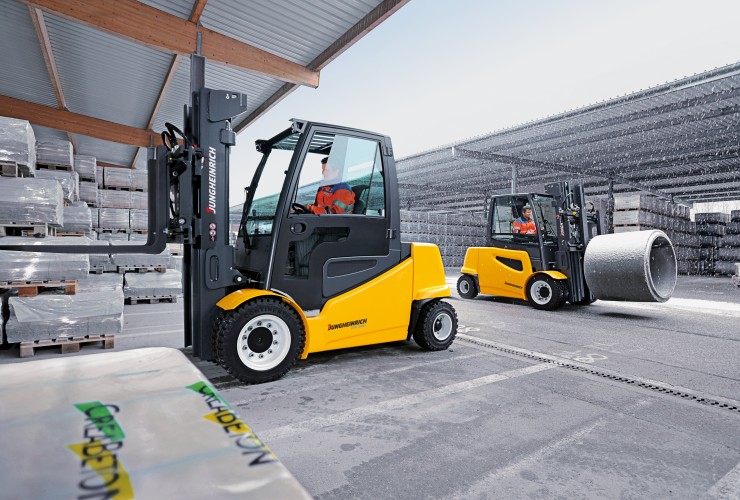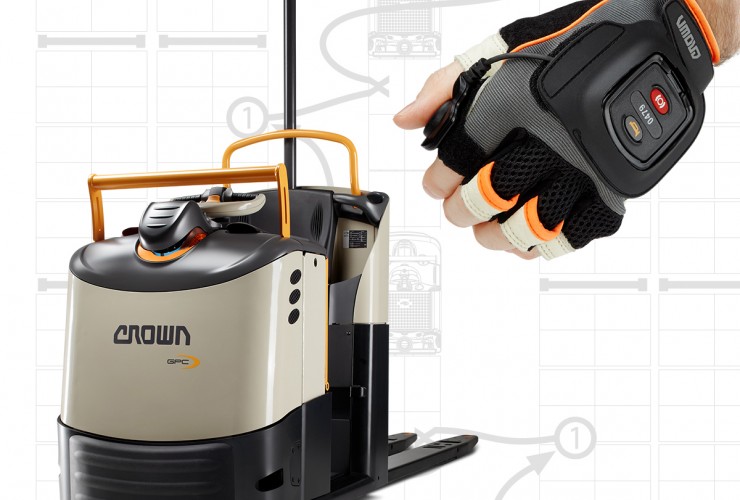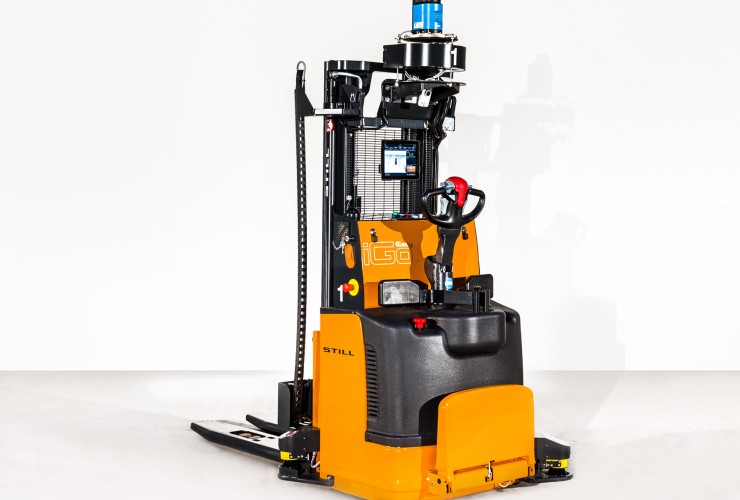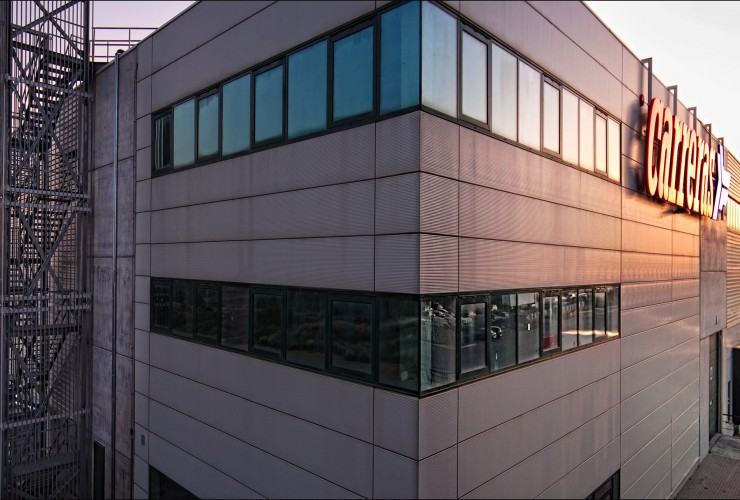IFOY Patronage
IFOY Sponsor
IFOY Partner
Messe Dortmund is official partner of the IFOY AWARD.
VIEW PAGE
Cascade is official partner of the IFOY AWARD.
VIEW PAGE
CHEP is official partner of the IFOY AWARD.
VIEW PAGE
LTG is official partner of the IFOY AWARD.
VIEW PAGE
The HERMES.Wirtschafts.Forum is official partner of the IFOY AWARD.
VIEW PAGE
Warsteiner is official partner of the IFOY AWARD.
VIEW PAGE
IFOY AWARD 2014
The Winners are ...
Counter Balanced Trucks up to 3.5 tons: Toyota Traigo 80
The IFOY Award 2014 in the "Counter Balanced Truck" category goes to the Toyota Traigo 80. The new Traigo 80 from Toyota is a sturdy, easy-to-operate and above all highly efficient forklift truck for loads up to 3.5 tons.
IFOY Award - Counter Balanced Truck of the Year 2014
The key factors in the choice of the Toyota Traigo 80 are its productivity and energy efficiency. With the Traigo 80, the higher driving and lifting speeds combined with more powerful acceleration boost productivity by 20 percent. This makes it one of the most energy-efficient forklifts in its class.
Toyota launched the 8FBMT25 series, better known as Traigo 80, last year. In the IFOY test, the 3.5-tonner scored highly for productivity and efficiency thanks to the maintenance-free Toyota AC motors, the newly developed control system and a more logical layout of components. The truck achieves a driving speed of up to 19 kmh on load trips. The lifting speed has been increased to 0.68 m/s without and 0.48 m/s with load. The Traigo 80 is therefore suitable for both light and heavy transport jobs.
In terms of productivity, the performance of the electric truck in the IFOY test was above-average, while energy consumption is also lower than the market average. In all drive modi – H (High Performance), P (Performance) and S (Standard) – the truck is more energy-efficient than average for its class. Toyota is therefore true to its word when it claims that the Traigo 80 has become around 20 percent more efficient.
During the IFOY test, the Traigo 80 made a robust and extremely solid impression. Whether battery cover, side panels or entrance - nearly all the elements are made of solid steel. The plastic components like the dashboard are equally robust and impact-proof.
The as-standard Toyota System for Active Stability (SAS) is a USP. Thanks to the steering synchroniser, the steering wheel is always in the ideal position during straight-ahead motion, for example. Other SAS features include rear axle locking in bends, automatic tilt angle limitation and limitation of tilting speed with raised forks and when the forks are automatically horizontally positioned during tilting. All in all, the IFOY test found that the SAS almost always guarantees a high level of safety and productivity. The Traigo 80 made an impressive showing in the test with its superb all-round visibility, its spacious and modern cabin, and the options for adjustment of the driver workplace to suit the needs of the specific driver. The compact design means that the Traigo can also be manoeuvred in narrow aisles.
The mast speed is fast and can be controlled via the mini-lever on the right-hand armrest. Dampening is also active in the lowest fork position. Through-mast visibility is also improved: the completely redesigned and broader mast (lifting height 3,300 mm) provides the driver with a clear view of the fork ends. The segments can be retracted, saving a great deal of space and ensuring that the mast is always narrow, thereby creating a good line of sight. In addition, the redesigned protective roof provides improved visibility, making the truck ideal for work at heights.
Counter Balanced Truck from 3.5 tons: Jungheinrich EFG S40
 The IFOY Award 2014 in the category "Counter Balanced Truck from 3.5 t" goes to the Jungheinrich EFG S40. For the first time in this vehicle class, the energy savings achieved by the combination of various measures ensure such a long operating time that the truck can work two full shifts without the need to change the battery.
The IFOY Award 2014 in the category "Counter Balanced Truck from 3.5 t" goes to the Jungheinrich EFG S40. For the first time in this vehicle class, the energy savings achieved by the combination of various measures ensure such a long operating time that the truck can work two full shifts without the need to change the battery.
IFOY Award - Counter Balanced Truck of the Year 2014
Jungheinrich has optimised various existing technologies and combined them in such a way that a truck in the class from 3.5 to 5 tons achieves an operating time that, in ideal situations, enables it to operate for two full shifts without the need for a battery change for the first time. In addition, the electric counter balanced truck is powerful and perfectly suited to outdoor operation. This makes it a real alternative to forklift trucks with combustion engines.
In the summer of 2013, Jungheinrich extended its forklift programme with a series specifically designed for heavy-duty use. The "S" series comprises three electric models and one diesel model for use with add-on devices or with very low loads.
The Forklift Truck of the Year 2014 demonstrated its power and precision during the IFOY test. With its top speed of 16.4 kmh, the EFG in the IFOY test is fast enough to remain fully controllable with and without load. The braking power on the drive motor depends on the selected drive mode and is almost always at the level that the driver would generally expect. Thanks to the new "Pure Energy" concept, the Jungheinrich truck achieves added energy savings without any sacrifice in terms of productivity. Pure Energy consists of the three components threephase technology, compact electronics and compact hydraulics. At the max settings (Drive Mode 5), productivity is only slightly (2.3%) lower than that of the high-performance 5-ton models while energy consumption is a massive 42% lower, increasing to 48 percent in energy-saving mode (Drive Mode 3), which means that the battery (930 Ah) in the EFG S40 is good for almost two full shifts.
The electric steering is precise and predictable. One new feature is the parameter steering, which adjusts the steering characteristics of the truck to suit the selected drive mode. This adaptive steering concept is a systematic further development of the assistant system from everyday road vehicles for use in MHE units. The support from the electrical steering system is high at low speeds, which means that the driver needs to make fewer steering adjustments. The level of support is lower at higher speeds. The main advantage is the precise steering which is easy to control at all speeds. Undesired steering motions are minimised, thereby ensuring extremely smooth steering of the truck. The steering column is equipped with a lever for height and tilt adjustment. The automatic parking brake works smoothly and flawlessly, and mast operation is as expected. The response of the single "Solo-Pilot" control lever is precise and the speeds are satisfactory.
The powerful appearance of the EFG S40 is instantly apparent. Both the front and rear axles are wider than usual and give the truck a "broad shoulder" look. The cabin step-up is slightly higher than in other trucks in this segment, but sufficiently spacious and convenient to ensure safe and easy entry and exit. The grey non-slip grating is easily visible and further enhances driver safety. The footwell is generously dimensioned and free of obstacles. Both the gas and brake pedals are set at a convenient height and distance.
Warehouse Truck: Crown GPC 3000 with QuickPick® remote
 The IFOY Award 2014 in the "Warehouse Truck" category goes to the Crown GPC 3000 low-lift order picker with Crown QuickPick® remote control. Thanks to the "magic glove", the operator can move the truck forward at the push of a button without having to be on-board and has both hands free.
The IFOY Award 2014 in the "Warehouse Truck" category goes to the Crown GPC 3000 low-lift order picker with Crown QuickPick® remote control. Thanks to the "magic glove", the operator can move the truck forward at the push of a button without having to be on-board and has both hands free.
IFOY Award - Warehouse Truck of the Year 2014
The highly innovative and well thought-out "magic glove" remote control concept was the key factor in choosing the Crown GPC 3000 with QuickPick remote control for the award. In terms of its highly intelligent operating concept and outstanding efficiency, QuickPick® Remote constitutes a genuine innovation that serves as a benchmark for all future semi-automatic order picking trucks.
The Crown GPC 3000 order picker with QuickPick feature was originally launched in early 2013. It officially came onto the European market in February 2014. The truck represents a new order picking technology that combines a Crown GPC 3000 low-lift order picker with an intuitive remote control system. Unlike in conventional pickers, the operator does not climb onto the picker to drive to the next picking station. Instead, he uses his thumb to press a button in his glove to navigate the truck to the next stopping point and walks alongside the truck. Thanks to the glove solution, the employee has both hands free to perform picking operations. The operator recognises intuitively when it is better to ride along on the truck or to use the QuickPick function. Research by Crown shows that this saves time, making the picking process up to 28 percent more efficient and also safer and more convenient.
The IFOY test with the Crown GPC 3000 confirmed this assessment. With average distances, the system is already roughly 10 percent more productive than when the operator is on-truck. The shorter the distances, the greater the benefits of the system: with average order picking distances of four metres, QuickPick is a massive 39.5 percent more productive. During the test, energy consumption in QuickPick mode was significantly lower (-18 percent) despite the higher productivity. Overall, the order picking process is quieter, smoother and considerably less tiring for the order picker.
Laser scanners on the forklift truck monitor the transport route as soon as the QuickPick feature is active. The speed is limited to the legal maximum of 4 kmh instead of the maximum speed of around 12.5 kmh. Acceleration time over a distance of 10 metres is doubled from 4.9 seconds to 8.9 seconds. If the system detects an obstacle, the machine stops automatically, continuing on its way once the route is clear once again. Moreover, the order picker is able to keep to a preselected side of the aisle (left, right or straight down the middle) with the help of the Auto Steer Correction feature. Potential obstacles, like a pallet that is not in the shelf, are avoided, and the order picker then automatically returns to its original "lane". This ensures minimum impact on productivity.
Automated Guided Vehicles: Still iGoEasy
 The IFOY Award 2014 in the "Automated Guided Vehicles" category goes to the iGoEasy concept from Still. The new combination of iPad and driverless EGV-S pedestrian high-lift stacker exploits the benefits of automation solutions in areas where the transport of goods was previously only feasible using a manually operated truck.
The IFOY Award 2014 in the "Automated Guided Vehicles" category goes to the iGoEasy concept from Still. The new combination of iPad and driverless EGV-S pedestrian high-lift stacker exploits the benefits of automation solutions in areas where the transport of goods was previously only feasible using a manually operated truck.
IFOY Award - Automated Guided Vehicle of the Year 2014
The idea is fascinatingly simple: to make an automation concept for MHE trucks so convenient to use that any customer can easily install it himself and adapt it to suit changing requirements and conditions. The iGoEasy system from Still is a genuine innovation and is unique in the marketplace. Normally, transport systems always have to be commissioned up by the manufacturer.
Still launched iGoEasy at the beginning of 2013, having developed the first system solution worldwide that allows full configuration, control and monitoring via an iPad for simple and standardised transport jobs, such as provision and retrieval to and from the production line.
During the IFOY test, the solution proved to be highly intuitive and extremely precise. It all starts with the teach-in process, during which the easy-to-understand user interface of the iGoEasy app guides the user through all the automation steps. First of all, reflectors are installed to identify the position of the truck, and the various positions are calibrated. To this end, the truck is manually guided along the desired route. A sensor built into the truck detects the reflectors and automatically transmits the coordinates to the on-board computer. The next task is to record the stopping points where the truck is to take on or unload pallets, the locations of the resting stations or the battery changing station. Up to eight stations can be logged. A height sensor stores - and subsequently monitors - the storage height of the pallets.
The app uses this data to generate and visualise the optimum route which can then be subsequently divided into segments and fine-tuned by the user. Changes to the route or settings, such as speed limits, one-way streets and station properties, can be made via the self-explanatory and intuitive iPad operating system.
After the route has been checked and approved, the truck can navigate its way fully autonomously through the warehouse and execute the learned commands: transport jobs are sent to the truck via WLAN by simply pressing the corresponding button of the mobile user device and automatically executed. The cockpit function complete with live image ensures that the user always has an excellent overview of the automated truck. The current position of the truck is shown on a virtual warehouse map, and important data such as speed, battery condition or transport jobs are displayed in the form of easy-to-understand graphics. New transport jobs are easy to generate and scheduled jobs easy to modify via the iGoEasy app. Moreover, frequently recurring transport jobs can be stored in a fast selector feature. The system can be controlled not just from within the warehouse but from any point within the range of the WLAN network. A further advantage is that iGoEasy ensures that damage to fixtures or buildings is a thing of the past. The high-lift truck is fitted with 2 sensors, which monitor the surroundings through a full 360 degrees. Two further sensors in the fork ends check whether the truck can actually drive into the waiting load.
Intralogistics Solution: Toyota I_Site
 The IFOY Award 2014 in the "Intralogistics Solution" category goes to Toyota Material Handling Europe. At Spanish logistics provider Carreras, the I_Site fleet management portal boosted productivity by 10 percent and cut the operating costs of the forklift fleet by around 60 percent within the space of a year. The Toyota system has meanwhile been introduced at most of the Carreras locations in Spain and Portugal.
The IFOY Award 2014 in the "Intralogistics Solution" category goes to Toyota Material Handling Europe. At Spanish logistics provider Carreras, the I_Site fleet management portal boosted productivity by 10 percent and cut the operating costs of the forklift fleet by around 60 percent within the space of a year. The Toyota system has meanwhile been introduced at most of the Carreras locations in Spain and Portugal.
IFOY Award - Intralogistics Solution of the Year 2014
The key factors were the strong focus on customer benefit and the resounding success of the solution. The implementation of I_Site in combination with a number of organisational measures generated significant economic gains for the customer. The jury is of the opinion that Toyota has impressively demonstrated the potential that can be exploited through the use of Web-based fleet management systems.
International logistics provider Carreras offers the full range of services typical for the sector, including transport, warehousing, distribution, transshipment of goods and packaging. Following a trial run, the company introduced the Toyota I_Site fleet management system in order to reduce damage costs in the forklift fleet while optimising the handling of goods. Toyota I_Site was implemented in nine centres within the space of a year - two in Saragossa, two in Madrid, and one each in Seville, Barcelona, Tarragona, Las Palmas (Gran Canaria) and Tenerife. The system was recently also introduced in Portugal (Lisbon and Pombal) as well as in Alicante and Valencia in Spain. The system was implemented at the various locations by the warehouse managers and their operations and maintenance technicians. This process also took account of the experiences gained at the first Toyota I_Site location, the company headquarters in Saragossa.
The system helps the Carreras Group to maintain an overview of the deployment of the entire forklift fleet with the support of the Web portal.
The company primarily pursues three goals: lower operating costs, improved safety and higher productivity. To this end, Toyota provided information from its pan-European service database and combined it with the technical, financial and administrative data of the Carreras fleet. This data includes such things as driving data, which is directly recorded in the trucks and then transmitted via GPRS. 300 of the 450 MHE trucks at Carreras are meanwhile managed via Toyota I_Site. The project has been a complete success, as "we recorded 10 percent higher productivity and 57 percent lower fleet operating costs for the period from 2009 to 2011", reports Fabio Furukawa, Productivity Manager in the Operations Management unit at Carreras.
One direct consequence of the use of I_Site was the optimisation of work processes: all travel times were measured and new pick-up points for the pallets defined. The resulting transparency also enabled Carreras to optimise the working capacity of drivers and machines, and to improve the utilisation efficiency of the trucks and batteries. "We were even able to optimise the fleet sizes. Although the implementation process necessitated additional investment, the benefits were so great that this investment has already paid for itself", says Jesus Carreras, Head of Purchasing at the Spanish logistics company.
Controlled access via PIN codes also has significant benefits in terms of security. It ensures that only trained, authorised personnel can operate the machines. A ranking system for the five best drivers and other safety incentives additionally help to avoid damage and unnecessary costs. In the event of a collision or serious impact, the forklift can be blocked and restricted to crawl speed. "This has made operation far safer. We have fewer collisions and accidents, and at the same time lower costs in areas like battery charging that used to be difficult to monitor", says Victor Dominguez, Machine/Installations Manager in the Operations Management unit at Carreras.
Carreras plans to introduce Toyota I_Site at all its warehouses.













